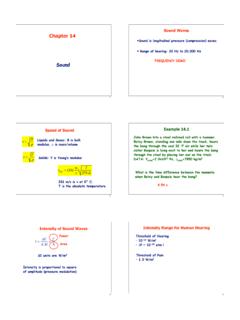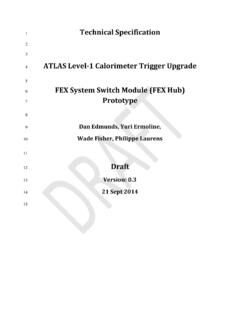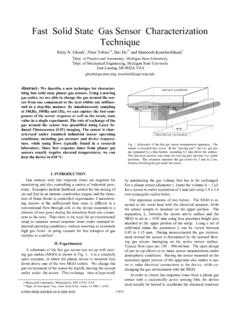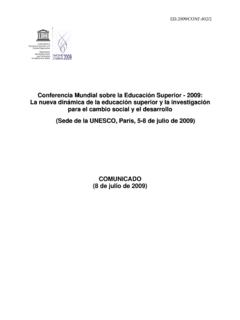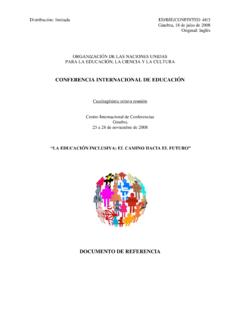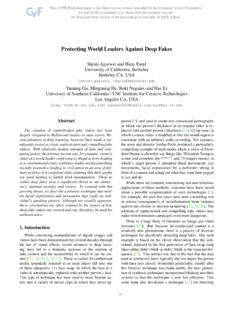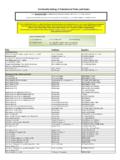Transcription of Plenty of Room at the Bottom - web.pa.msu.edu
1 Plenty of Room at the Bottom Richard P. Feynman (Dated: Dec. 1959). This is the transcript of a talk presented by Richard P. Feynman to the American Physical Society in Pasadena on December 1959, which explores the immense possibilities afforded by miniaturization. I imagine experimental physicists must often look with can easily be adjusted in size as required by the photo- envy at men like Kamerlingh Onnes, who discovered a engraving, and there is no question that there is enough field like low temperature, which seems to be bottomless room on the head of a pin to put all of the Encyclopaedia and in which one can go down and down.
2 Such a man Brittanica. is then a leader and has some temporary monopoly in Furthermore, it can be read if it is so written. Let's a scientific adventure. Percy Bridgman, in designing a imagine that it is written in raised letters of metal; that way to obtain higher pressures, opened up another new is, where the black is in the Encyclopedia, we have raised field and was able to move into it and to lead us all along. letters of metal that are actually 1/25,000 of their ordi- The development of ever higher vacuum was a continuing nary size.
3 How would we read it? development of the same kind. If we had something written in such a way, we could I would like to describe a field, in which little has been read it using techniques in common use today. (They will done, but in which an enormous amount can be done in undoubtedly find a better way when we do actually have principle. This field is not quite the same as the others it written, but to make my point conservatively I shall in that it will not tell us much of fundamental physics (in just take techniques we know today.))
4 We would press the sense of, What are the strange particles? ) but it is the metal into a plastic material and make a mold of it, more like solid-state physics in the sense that it might tell then peel the plastic off very carefully, evaporate silica us much of great interest about the strange phenomena into the plastic to get a very thin film, then shadow it by that occur in complex situations. Furthermore, a point evaporating gold at an angle against the silica so that all that is most important is that it would have an enormous the little letters will appear clearly, dissolve the plastic number of technical applications.
5 Away from the silica film, and then look through it with What I want to talk about is the problem of manipu- an electron microscope! lating and controlling things on a small scale. There is no question that if the thing were reduced by As soon as I mention this, people tell me about minia- 25,000 times in the form of raised letters on the pin, it turization, and how far it has progressed today. They tell would be easy for us to read it today. Furthermore; there me about electric motors that are the size of the nail on is no question that we would find it easy to make copies your small finger.
6 And there is a device on the market, of the master; we would just need to press the same metal they tell me, by which you can write the Lord's Prayer plate again into plastic and we would have another copy. on the head of a pin. But that's nothing; that's the most How do we write small? primitive, halting step in the direction I intend to dis- The next question is: How do we write it? We have cuss. It is a staggeringly small world that is below. In no standard technique to do this now. But let me argue the year 2000, when they look back at this age, they will that it is not as difficult as it first appears to be.
7 We wonder why it was not until the year 1960 that anybody can reverse the lenses of the electron microscope in or- began seriously to move in this direction. der to demagnify as well as magnify. A source of ions, Why cannot we write the entire 24 volumes of the En- sent through the microscope lenses in reverse, could be cyclopedia Brittanica on the head of a pin? focused to a very small spot. We could write with that Let's see what would be involved. The head of a pin is spot like we write in a TV cathode ray oscilloscope, by a sixteenth of an inch across.
8 If you magnify it by 25,000 going across in lines, and having an adjustment which diameters, the area of the head of the pin is then equal to determines the amount of material which is going to be the area of all the pages of the Encyclopaedia Brittanica. deposited as we scan in lines. Therefore, all it is necessary to do is to reduce in size This method might be very slow because of space all the writing in the Encyclopaedia by 25,000 times. Is charge limitations. There will be more rapid methods. that possible?
9 The resolving power of the eye is about We could first make, perhaps by some photo process, a 1/120 of an inch that is roughly the diameter of one of screen which has holes in it in the form of the letters. the little dots on the fine half-tone reproductions in the Then we would strike an arc behind the holes and draw Encyclopaedia. This, when you demagnify it by 25,000 metallic ions through the holes; then we could again use times, is still 80 angstroms in diameter 32 atoms across, our system of lenses and make a small image in the form in an ordinary metal.
10 In other words, one of those dots of ions, which would deposit the metal on the pin. still would contain in its area 1,000 atoms. So, each dot A simpler way might be this (though I am not sure it 2. would work): We take light and, through an optical mi- air mail letter. croscope running backwards, we focus it onto a very small Now, the name of this talk is There is Plenty of Room photoelectric screen. Then electrons come away from the at the Bottom not just There is Room at the Bot- screen where the light is shining.
